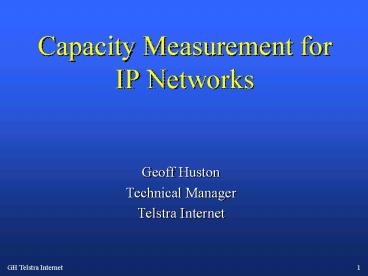Capacity Measurement for IP Networks - PowerPoint PPT Presentation
Title:
Capacity Measurement for IP Networks
Description:
TCP/IP Protocol Issues. No network-based flow control mechanism ... TCP/IP Protocol Issues. Damping network capacity is not a demand management tool ... – PowerPoint PPT presentation
Number of Views:50
Avg rating:3.0/5.0
Title: Capacity Measurement for IP Networks
1
Capacity Measurement for IP Networks
- Geoff Huston
- Technical Manager
- Telstra Internet
2
TCP/IP Protocol Issues
- TCP/IP is NOT a flow damped protocol
- end to end flow management
- sliding window protocol
- adaptive flow rate designed to probe and use max
available end to end bandwidth - only limited by end system buffering size
- bandwidth x delay
3
TCP/IP Protocol Issues
TCP/IP Data Flow Rate Adaptation
Steady State Available Bandwidth
Data Flow Rate
Time
4
TCP/IP Protocol Issues
- No network-based flow control mechanism
- Network-based packet loss signals end systems to
collapse window size - Varying window size allows adaptive flow metrics
to adapt to changing maximum available capacity - Sustained insufficient capacity leads to
congestion induced collapse of data throughput
5
TCP/IP Protocol Issues
TCP/IP efficiency under congestion load
33 66
Data Throughput
33 66
Traffic Level
6
TCP/IP Protocol Issues
- TCP vs UDP
- UDP-based applications
- Internet Phone, Video, Workgroup
- UDP Issues
- no flow control mechanism
- sustained use forces precedence over TCP flows
- increasing use of flow bandwitdh negotiated
protocols for these applications (RTP)
7
TCP/IP Protocol Issues
- Damping network capacity is not a demand
management tool - Network capacity must be available to meet peak
demand levels without congestion loss
8
Usage Profile
- Two major Internet use profiles
- Business use profile
- peak at 1500 - 1600
- plateau 1000 - 1730
- Residential dial profile
- peak at 2030 - 2330
- plateau 1900 - 2400
9
Usage Profile
- Distance profiles
- 30 Local
- 40 Domestic Trunk
- 30 International
- Traffic mix due to
- Distance invisible applications without user
control - Distance independent tariff
10
Capacity Guidelines
- Link Utilisation
- Average weekly traffic level set to 40 of
available bandwidth. - Core network capacity should be in excess of
access bandwidth
11
Link Usage Profile - optimal
- peak loading less than 10 time
- greater than 50 loading for 50 time
- traffic bursting visible
12
Link Usage Profile - overloaded
- 90 peak loading for 45 time
- 60 peak loading for 60 time
- no burst profile at peak loads
- imbalanced traffic (import based)
13
Link Usage Profile - saturated
- visible plateau traffic load signature
- small load increases cause widening plateau
14
Overall Growth Levels
- More users
- More intense network use by increasingly
sophisticated applications - No visible saturation of demand to date

